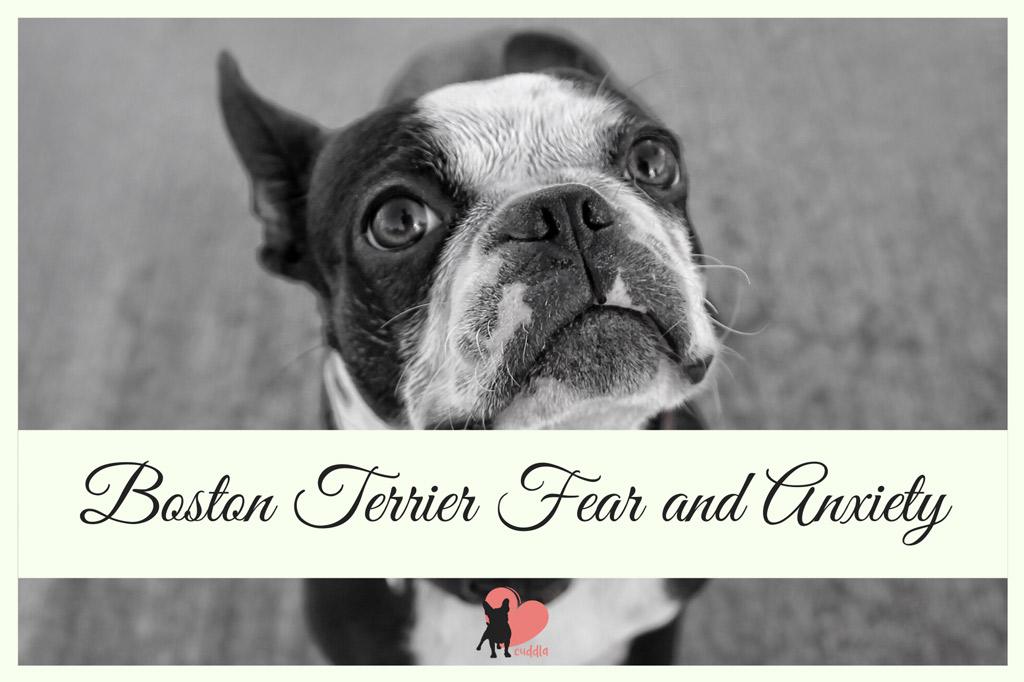
Wondering why your Boston is freaking out every time you turn on the hoover or seems to panic easily?
Are Boston Terriers nervous dogs? Apart from separation anxiety, Boston Terriers can also suffer from situational anxiety and develop fears. Boston can get nervous due to fireworks, thunder, visits to the vet, etc.
Continue reading to discover the signs, causes, and remedies to Boston Terrier’s fears and situational anxiety.
Boston Terrier Fears
Fears in dogs (also known as canine phobias) are common, and Boston Terriers are no exception.
Do Boston Terrier Have Anxiety?
Boston Terriers are prone to separation anxiety, a state of extreme anxiety or panic due to the dog being separated from his owner.
Separation anxiety is the most common example of a situational phobia.
But that’s not all, Bostons can also experience other types of situational anxiety or fears.
Fear is the instinctual feeling of apprehension resulting from a situation, person, or object presenting an external threat, whether real or perceived.
The persistent and excessive fear of a specific stimulus is referred to as a phobia. When a dramatic event has been experienced, then any event associated with it, or the memory of it, is sufficient enough to generate a response.
Read also: Boston Terrier Separation Anxiety – 16 Things that Help.
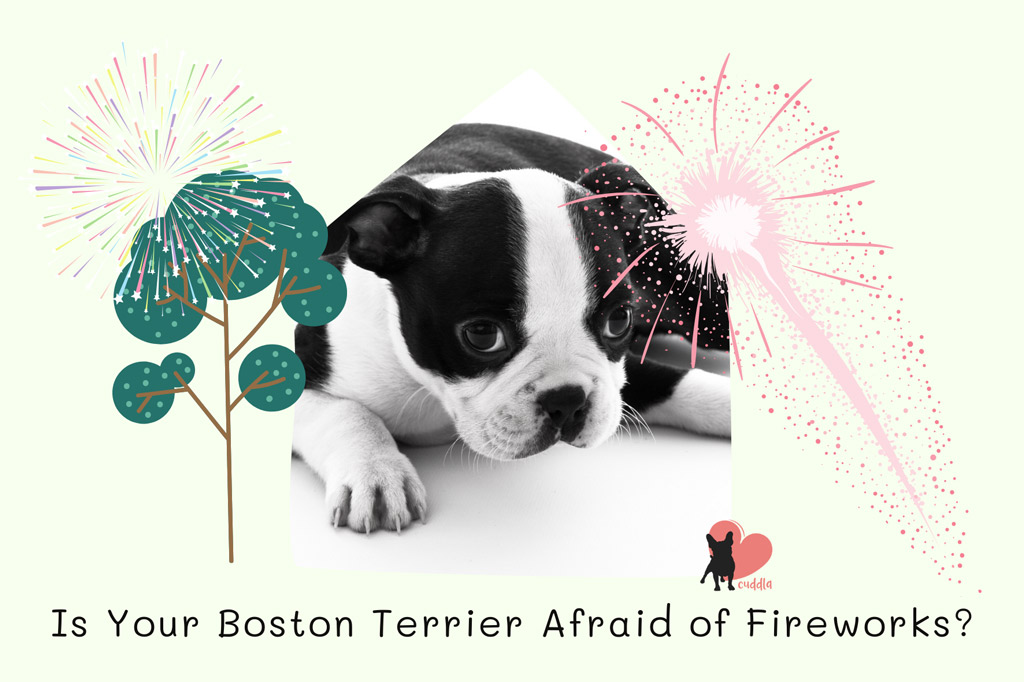
Are Boston Terriers Nervous Dogs?
Going by their breed characteristics, Boston Terriers wouldn’t be classified as nervous dogs “by default”.
But, depending on genetics, socialization and traumatic experiences, Boston Terriers can become nervous.
As a consequence, some Bostons develop fears and situational phobias (like separation anxiety) related to a specific trigger.
What Do Boston Terriers Fear?
Boston Terrier’s fears can be associated to different triggers.
The most common phobias are associated with noises, such as thunderstorms or fireworks.
Here’s a list of common dog fears:
- Fear of thunder.
- Fear of fireworks.
- Fear of the veterinarian.
- Fear of riding on a car.
- Fear of strangers.
- Fear of men.
- Fear of children.
- Fear of objects.
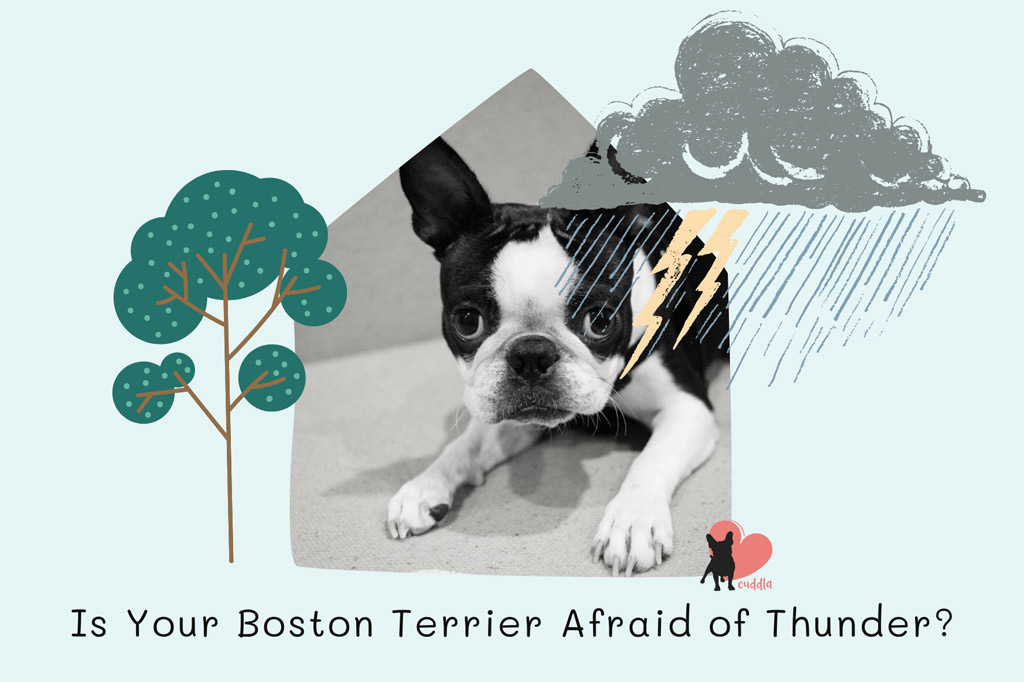
What Are the Fear and Anxiety Signs in Boston Terriers?
Dogs communicate using body language – even if some of this body language is very subtle.
There are several signs to look out for to determine when your Boston Terrier is feeling fear or anxiety.
Here’s a list of the 12 most common anxiety signs for dogs:
- Non-stop barking or howling.
- Urine dribbling.
- Chewing everything in sight.
- Exhaling sharply (chuffing).
- Tail thumping.
- Escaping.
- Yawning constantly.
- Shaking and trembling.
- Hiding.
- Scratching.
- Tail between legs (not applicable for Bostons).
“Pacing, drooling, constant yawning, lip licking, scratching, and general body tension can all be signs of anxiety.
These are collectively known as ‘calming signals.’ They’re also normal behaviours, but are potential signs of anxiety when they are out of context.”
Kayla Fratt, an associate certified dog behavior consultant.
Read also: Why Do Boston Terriers Shake or Shiver? Good or Bad?
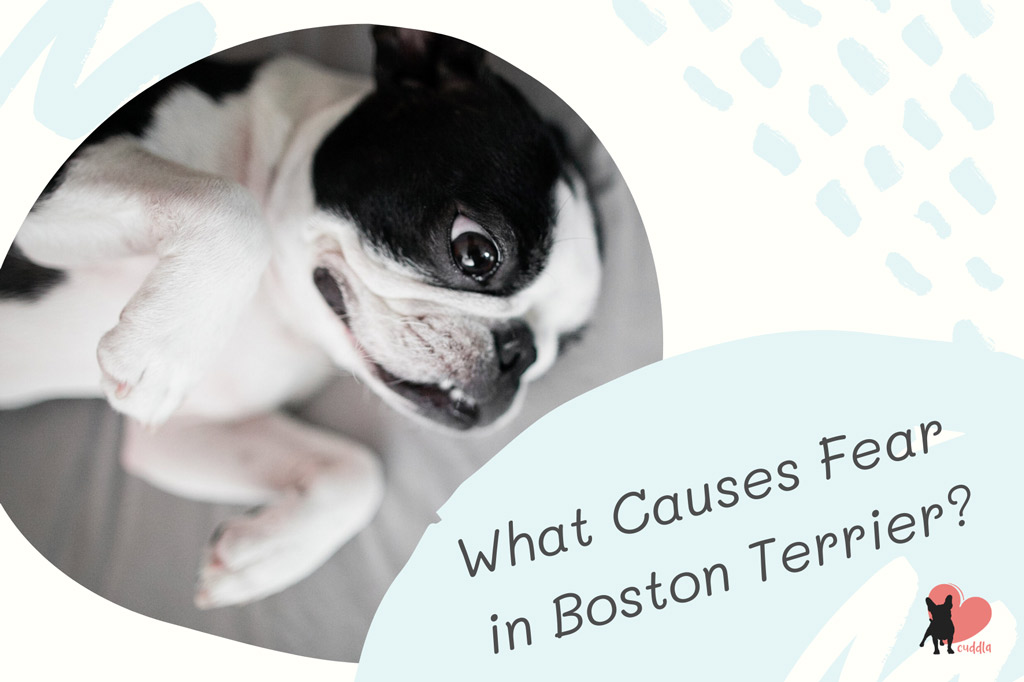
What Are the Causes of Fear in Boston Terriers?
Fearful tendencies in dogs can have a single cause or be a combination of the causes.
These are the four basic causes of fear in dogs:
- Genetics.
- Lack of socialization.
- A specific situation caused a fearful response.
- By association.
#1 – Genetics
Some Boston Terriers are born with a lower tolerance to stressors and anxiety-provoking situations because it’s been passed on to them by their parents.
#2 – Lack of Socialization
The lack of proper socialization during critical socialization periods can make your Boston Terrier fearful of other dogs, pets, people and children since he hasn’t become resilient in the face of unsettling situations.
Puppies progress through learning and development stages just as human children do.
By exposing your Boston to different kinds of people, animals and environments, you can help him become confident and calm.
However, socialization is not just for puppies – you should continue with social exposure throughout your Boston Terrier’s life.
Read also: Boston Terrier Socialization In 8 Steps.
#3 – A Specific Situation Caused a Fearful Response
There are many situations that can cause a fearful response for your Boston:
- Moving house.
- Welcoming a new house member.
- Noises.
- A traumatic event: mistreat, abandonment, etc.
For instance, a dog can be fearful of men because he has been abused or treated badly by a man who was his previous owner.
#4 – By Association
Finally, fears can also spread by association, i.e., your dog relating something good with pain.
For example, your dog likes playing with children but at the same time, you are teaching him to come to you with a shock collar. He will soon associate playing with children with the pain of an electric collar and could develop aggressive behaviour.
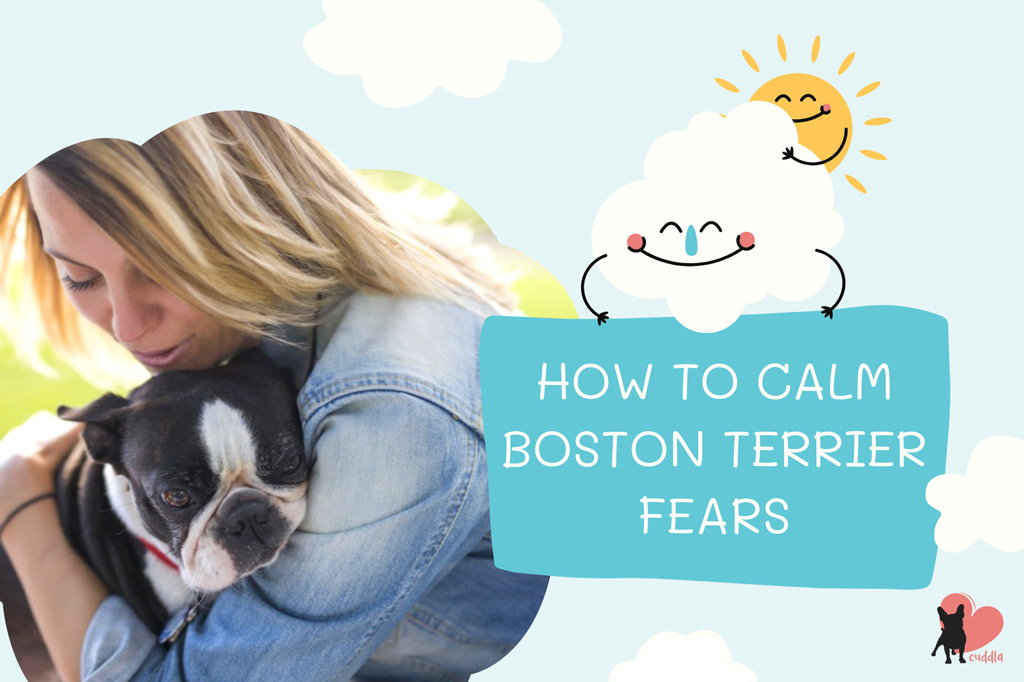
How to Calm Your Boston Terrier’s Fears
Here are some tips to calm your Boston Terrier’s fears or situational anxiety:
I’m sure you may have already heard of some of them and may come across too simple, but they definitely work. You just need to find which ones suit your Boston best! 😉
#1 – Create a Dog Safe Zone
A dog safe zone isn’t hard to create, but it does require some thought. You want to make sure that your Boston Terrier’s spot is safe and comfortable for his inquisitive nose and playful manners.
These zones are very important, especially when considering a study that showed 42-58% of dogs tend to react to stress and anxiety by hiding or withdrawing, depending on the situation (source).
So having a safe space or a den for your Boston is a great start. You can place his bed, a blanket and special toys that help in his zone.
Insider Tip: It helps if your dog’s safe zone is located in a relatively quiet spot in the house.
During thunder or fireworks, you could:
- Walk your Boston earlier on 5th November.
- Draw the curtains before the trigger starts.
- Close all windows and doors to minimize the noise.
Read also: How to Create a Dog Safe Zone for Your Pooch to Relax.
#2 – Provide Special Toys
When you leave your Boston at home alone, you can provide him with interactive and plush toys. for him to focus on in your absence.
These interactive toys are a great for your Boston Terrier to focus on in your absence or when you are busy:
- A seek-a-treat puzzle: A Snuffle Mat challenges your Boston to use his nose and paws to find treats.
- A dog puzzle or “busy box” toy: It’s designed to challenge your dog. It contains compartments that hide food and require your pooch to figure out how to get to the food using his nose, mouth, and paws. Trixie puzzle toy, for example, has different training levels to increase the challenge!
- A treat ball toy: Bob-A-Lot gives your pooch something fun to chase around the room and surprise him with a tasty reward!
- Dispenser toys: Kongs are a classic option in this range. It comes in all sizes and for all ages. You can fill it with part of his meal. Also, you can freeze it for an extra challenge.
Plush toys, on the other hand, make a great companion. They are designed to soothe dogs like Smart Pet Love’s Snuggle Puppy Toy.
Alternatively, you can always leave your Boston Terrier with an old t-shirt or blanket with your scent on it.
Read also: Can a Boston Terrier Be Left Alone? For How Long?
#3 – Make Exercise a Priority
Continue to stimulate your Boston Terrier mentally and physically (and this should continue throughout their lifetime).
Make sure your Boston gets plenty of exercise (like a 40-minute walk prior to being left alone all day) and quality dog playtime after you get back.
The fuller your dog’s life is when you are around, the calmer he will be when you are not there.
Exercises like playtime, training and walks helps your dog expend energy, which releases endorphins into the brain and supports mental health.
Insider Tip: It definitely helps if you can get your dog to just chill out (by giving him some space, for example) after doing some exercise and being feed. He will be more likely to take a nap.
When you don’t have the time to do it yourself, hire a professional dog walker. There are a lot of dog walking services around these days, depending on where you live.
If you decide to go this route, be sure to do your homework and find a reputable one.
Don’t skip my favourite dog care for my top pick for dog walking help!
Read also: How Much Exercise Do Boston Terriers Need? Age-Specific.
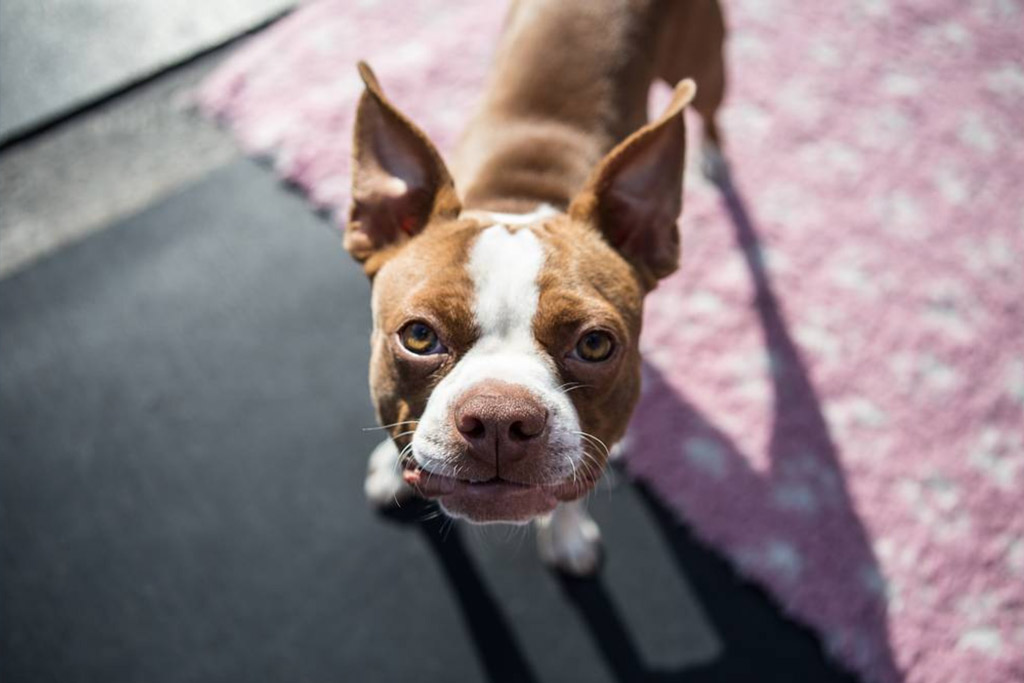
#4 – Put Some Music On
You can play calm, soothing music or white noise sounds (both available on Amazon) before a possible stressor occurs.
These sounds tend to relax dogs. Plus, they have the added bonus of drowning out distressing noises.
#5 – Give A Massage
Massaging your Boston and talking softly can help. You can give your dog a home massage by rubbing his belly gently.
If your pooch seems to respond well to pressure applied to his body, there are wraps available like Thundershirt anxiety jacket that can be very helpful.
Also, you can try Ttouch, a specific massage technique that can help anxious pets. Tellington TTouch is a gentle, positive method for training and healing companion animals. It has the power to reshape a dog’s behaviour through kindness and understanding.
Check out the book Getting in TTouch with your Dog: A Gentle Approach to Influencing Behaviour, Health and Performance to learn more about this massage technique.
#6 – Sooth The Other Senses Too
Here are three options:
A Herbal Infusion
Calming herbs that can be of benefit include ashwagandha and chamomile. Consult your holistic veterinarian about which makes sense for your Boston Terrier.
Lavender Essential Oil
The lavender essential oil has also been proven to reduce a dog’s stress response. You can place two drops on your Boston’s collar or bedding before a stressor occurs.
Otherwise, you can use a diffuser (like I do) around your house for an overall calming effect.
Adaptil
As an alternative to lavender, Adaptil it’s a well-known diffuser to curb stress-related unwanted behaviours. The diffuser emits an odourless pheromone that provides a strong signal of comfort and security to dogs.
Read also: 10 Steps to Dog Home Alone Safety and How to Keep My Dog Entertained While at Work blog posts.

How to Help Your Boston Terrier Overcome His Fears
Finally, you no doubt want your Boston to overcome his fears.
Good news is that most fear reactions are learned and can be unlearned with gradual exposure.
#1 – Don’t Use Negative Training
When treating a fearful dog:
- Don’t get angry: Although teaching your Boston to overcome anxiety can be tough and challenging, stay strong, positive, and don’t get angry. Boston Terriers are sensitive to your tone of voice and feelings.
- Don’t punish: Punitive training methods like shock collars, yelling, hitting, etc. don’t work; they only make things worse. Boston Terriers are also very sensitive to negative training methods.
- Don’t yell “No”: Saying “no” to your doggie without offering an alternative turns your “no” into an interruption, not a request or demand.
Insider Tip: Punitive or aggressive methods should never be used. This will only create more fear and distrust, i.e., it will do nothing to build confidence and trust in the associated situation.
Instead, follow a reward-based training to establish good structure and boundaries within the home environment as well as communication directed towards your Boston.
This will build your Boston Terrier’s confidence and ability to succeed, plus it gives support through predictability and consistency.
#2 – Follow a Desensitisation Process
Desensitisation means gradually exposing your anxious Boston Terrier to the thing he’s scared of (the trigger).
Fear in dogs is reduced when they see the frightening stimuli from a distance, where it isn’t threatening, and it is slowly and steadily brought nearer.
Listening to your scared pooch and removing them from the situation would be the best first step.
It’s a good idea to consult a dog behaviourist to know how to proceed for your dog’s particular fear, especially in extreme or prolonged cases.
If your dog is scared of noises like thunder or fireworks, you can expose him to the noise by playing the recorded sound in low volume first and gradually increasing it during the following days.
Also, tossing treats or toys to a fearful dog can teach him to associate approaching strangers with something good, as long as the treat is high-value and the visitor is far enough away to avoid overwhelming the dog.
Finally, you want to address these behaviours early because you don’t want them to escalate until they become deeply rooted.
This will have bigger consequences, such as aggression, and your Boston Terrier might end up being very unhappy and stressed a lot of the time, which is unpleasant for both of you.
Read also: How to Care for a Boston Terrier in 5 Steps – Beginner’s Guide.

